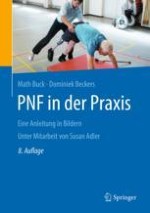Erschienen in:
2019 | OriginalPaper | Buchkapitel
4. Befundaufnahme und Behandlung
Zusammenfassung
In diesem Kapitel wird das Vorgehen für einen PNF-Befund beschrieben: Von der Erstellen einer Hypothese, Tests auf struktureller Ebene und auf Aktivitätsebenen, Formulierung der Behandlungsziele sowie die Planung und Ausführung der Behandlung erläutert. Ebenso wird auf Re-Test zum Überprüfen von Veränderungen der Schädigungen und Einschränkungen der Aktivitäten eingegangen.
Anzeige














